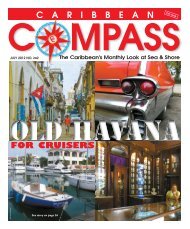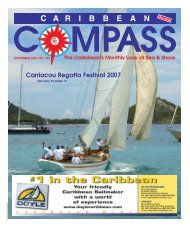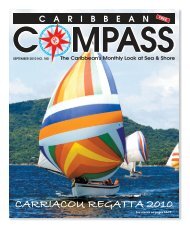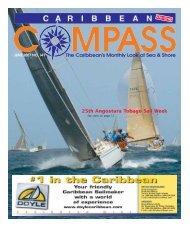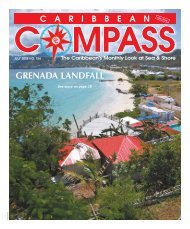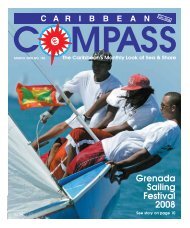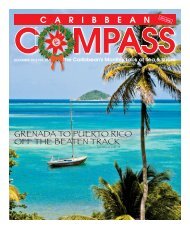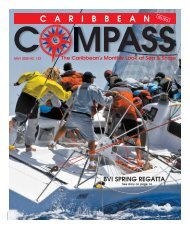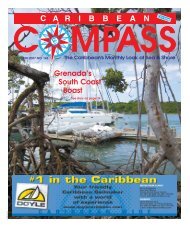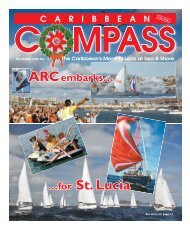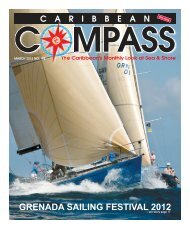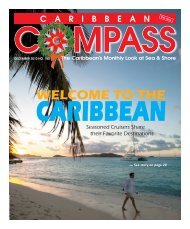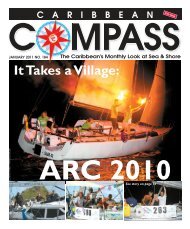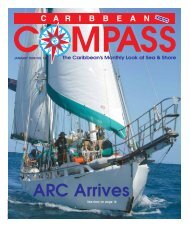do where do you want you want - Caribbean Compass
do where do you want you want - Caribbean Compass
do where do you want you want - Caribbean Compass
You also want an ePaper? Increase the reach of your titles
YUMPU automatically turns print PDFs into web optimized ePapers that Google loves.
DECEMBER 2011 CARIBBEAN COMPASS PAGE 24<br />
A Taste of Trini:<br />
Feasting Your Way<br />
Around the Island<br />
OKAY, I admit it: I’m a foodaholic. I read cookbooks for fun. I subject friends to the<br />
dubious results of my culinary experiments. And when presented with a menu, I<br />
consider the gustatory attributes of each and every dish listed before ordering. So<br />
how could I pass up the chance to travel the back roads of Trinidad, nibbling here<br />
and sipping there, tasting the best the island has to offer?<br />
My husband, Chris, and I had arrived in Trinidad on our Bruce Roberts sloop, Mr<br />
Mac, with boat work high on the agenda. But after the topsides and hull were painted,<br />
we turned our sights toward having fun, Trinidadian style. We signed up for A<br />
Taste of Trini, the newest tour offered by Jesse James with ‘Members Only’ Maxi Taxi<br />
Service (http://www.membersonlymaxitaxi.com). We had already tasted some of the<br />
wonderful local cuisine: <strong>do</strong>ubles, rotis, curries galore. Jesse offered the chance to get<br />
away from the boatyards of Chaguaramas and explore back-road food stands frequented<br />
by locals, but virtually unknown to visitors.<br />
Jesse picked us up, eleven cruisers in all, from our respective boatyards and marinas<br />
at 9:00AM. The van was comfortable and air-conditioned, and there was a cooler<br />
full of ice for our drinks (water and Gatorade at this time of day). As we headed out<br />
of Chaguaramas, Jesse regaled us with stories of the local history and geography.<br />
Our first stop was only about 20 minutes into our trip. Pulling over to the side of<br />
the busy Western Main Road, Jesse jumped out and came back with bags of <strong>do</strong>ubles.<br />
Doubles are tasty treats of barra (a soft flatbread) and channa (curried chickpeas).<br />
Traditionally called “barra and channa”, they became “<strong>do</strong>ubles” after the practice of<br />
using two barra, instead of just one, became popular. The ven<strong>do</strong>r places the barra,<br />
slightly overlapping, on a piece of paper, and tops them with the channa and, if<br />
requested, pepper sauce. With a quick flick of the wrist, the ven<strong>do</strong>r wraps the <strong>do</strong>uble<br />
tightly in the paper and hands it to the customer. This is not food <strong>you</strong> eat in the car<br />
with one hand on the wheel. Doubles are incredibly messy — chickpeas escape and<br />
the juice dribbles <strong>do</strong>wn <strong>you</strong>r chin and hands. Ven<strong>do</strong>rs are generally surrounded by<br />
savvy customers striking the typical <strong>do</strong>ubles-eating pose, bent way over at the waist,<br />
holding the <strong>do</strong>uble well away from their clothing and shoes. Messy… but delicious.<br />
Our appetites whetted, we continued through Port of Spain and onto the Churchill-<br />
Roosevelt Highway. The road cuts through the breadbasket of Trinidad, the fertile<br />
lands between the Northern and Central Mountain Ranges. As we headed east, Jesse<br />
briefed us on the country’s agricultural history. For many years, agriculture was<br />
king in Trinidad. In the late 1800s and early 1900s, cocoa and coffee estates flourished<br />
in the cool mountainous areas. Then witches’ broom, a fungal disease,<br />
attacked the cocoa crops, decimating the harvest. Sugarcane, a lowland crop, rose<br />
Since 1984<br />
by Anne McMillen-Jackson<br />
Colorful (and powerful!) condiments available at a roadside stand<br />
to importance as the nation’s most valuable agricultural product. But as oil revenues<br />
increased, Trinidad’s agricultural sector took a backseat, and the country began<br />
importing foods that previously had been grown here. Fortunately, that trend has<br />
reversed with recent programs to revitalize agriculture. There are numerous small,<br />
family-run farms producing crops for local consumption, and we saw many roadside<br />
stands offering homegrown fruits and vegetables. Interest in high-quality Trinidadian<br />
Munching on watermelon fresh from the field<br />
cocoa is also on the rise; Valrhona, the French chocolatier, uses only cocoa from an<br />
estate in Gran Couva, in west-central Trinidad, to make their premium “Gran Couva”<br />
chocolate bars.<br />
Turning off to the north, we travelled to the Eastern Main Road and the town of<br />
Valencia, home of the barbecued pigtail. Yes, that’s pigtail, as in the curly end of the<br />
pig. We stopped at one of the many shops offering this delicacy, and Jesse ordered up<br />
two large servings to pass around. The sauce was delicious, but the texture was not<br />
to my taste. I was the lone one in the crowd, though; everyone else gobbled them <strong>do</strong>wn<br />
and happily licked their fingers clean. Our post-pigtail treat was a rainbow-colored<br />
smoothie next <strong>do</strong>or.<br />
Heading southeast, we passed by the Aripo Savannas Scientific Reserve, a bird sanctuary<br />
and research area <strong>where</strong> many avian species have been re-introduced and now<br />
thrive. Further along in Sangre Grande, we saw a woman selling pee wah. The pee wah<br />
fruit, also called peach palm, is colored green to orange, and hangs in clumps beneath<br />
the fronds of the palm tree. It’s only available in the fall. The fruit are boiled whole in<br />
salted water for 15 to 20 minutes, then the skin is peeled off and the seed removed. The<br />
remaining pulp is what is eaten, and Jesse said it resembles sweet potato in taste.<br />
Interestingly, our next stop was a roadside stand in the middle of a Sangre Grande<br />
residential area. The glass case on the counter was filled with a variety of freshly<br />
made snacks. Saheena is made from callaloo (dasheen) leaves rolled, sliced, dipped<br />
in split-pea batter and fried, crispy and tasty with pepper sauce on top. Aloo (or<br />
potato) pie is a slender fried <strong>do</strong>ugh served sliced across the top and stuffed with hot<br />
sauce. Baiganee is a long slice of eggplant battered and fried. Kitchorie are fried balls<br />
of yellow split-pea <strong>do</strong>ugh, cut not quite through into quarters and topped with channa.<br />
They also had <strong>do</strong>ubles, but we had already tried those and were saving space for<br />
new taste treats. Although everything was fried, nothing was heavy and greasy, probably<br />
because the items were so fresh, cooked less than ten feet away. While we ate<br />
we watched colorful Hindu prayer flags, common in the yards of many of the homes<br />
in this area, flutter in the breeze. They reminded us that the culinary traditions of<br />
East Indians, first brought to Trinidad from India in 1845 as indentured servants,<br />
strongly influence the foods of the island.<br />
The road toward the coast was hilly, winding through forests with thick stands of<br />
bamboo and palms. Our goal was a beach park at Manzanilla, <strong>where</strong> Jesse set up the<br />
fixings for the next portion of our feast. He had brought some mysterious bags into<br />
the van at our last stop, and now he revealed their contents, spiced stew beef and<br />
several curries: goat, mango, chicken gizzards, and bodi (long green beans chopped<br />
small for this dish). To go along with these were two types of roti bread: paratha and<br />
dhalpouri. Paratha roti is a thin, flexible round flatbread eaten alongside the meat or<br />
vegetables as buss-up-shut (the bread is basically smacked around to break it up, so<br />
it looks like a “busted-up shirt”). Dhalpouri roti has a layer of yellow split peas within<br />
the thin bread, and is generally used to encase the filling, rather like a burrito.<br />
—Continued on next page<br />
Barefoot Yacht Charters & Marine Centre<br />
BAREBOAT CHARTERS - FULLY CREWED CHARTERS - ASA SAILING SCHOOL<br />
• Doyle Sail Loft & Canvas Shop • Raymarine Electronics • Refrigeration Work<br />
• Mechanical & Electrical Repairs • Fibreglass Repairs • Laundry<br />
• Vehicle Rentals • Showers • Air Travel<br />
• Ice & Water • Diesel & Propane • Moorings<br />
• Island Tours • Surftech Surf Shop • Hotel Reservations<br />
• Quiksilver Surf Wear • Restaurant & Bar • Boutique<br />
• On-site Accommodation • Wi-Fi / Internet Café • Book Exchange<br />
PO Box 39, Blue Lagoon, St Vincent, West Indies<br />
Tel. 1-784-456-9526 / 9334 / 9144 Fax. 1-784-456-9238<br />
barebum@vincysurf.com www.barefootyachts.com



